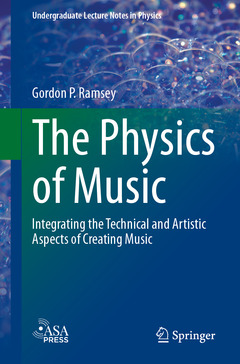Description
The Physics of Music, 1st ed. 2024
Integrating the Technical and Artistic Aspects of Creating Music
Undergraduate Lecture Notes in Physics Series
Author: Ramsey Gordon P.
Language: English
Subjects for The Physics of Music:
Publication date: 05-2024
366 p. · 15.5x23.5 cm · Paperback
366 p. · 15.5x23.5 cm · Paperback
Description
/li>Contents
/li>Biography
/li>Comment
/li>
This textbook is designed to help students and professionals understand the intimate connection between music and physics. The reader does not need prior background in music or physics, as the concepts necessary for understanding this connection are developed from scratch, using nothing more sophisticated than basic algebra which is reviewed for the reader. The focus is on connecting physics to the creation of music and its effect on humans. The reader will learn about the basic structure of music in relation to acoustics concepts, different musical instrument groups, how the room affects sound, and how sound travels from instruments to human ears to evoke an emotional reaction. Replete with exercises to hone students? understanding, this book is ideal for a course on the physics of music and will appeal to STEM students as well as students, professionals, and enthusiasts in any field related to music and sound engineering.
Chapter 1. Introduction.- Chapter 2. Language, Structure and Function of Music.- Chapter 3. Physics Concepts.- Chapter 4. Introduction to the Instrument Groups.- Chapter 5. Brass Instrument Group.- Chapter 6. Stringed Instrument Group.- Chapter 7. Woodwind Instrument Group.- Chapter 8. Percussion Instrument Group.- Chapter 9. Electronic Instrument Group.- Chapter 10. The Voice Group.- Chapter 11. Room Acoustics.- Chapter 12. Epilog: Connecting the Concepts.
Gordon Ramsey is Emeritus Professor of Physics at Loyola University Chicago. He received a Ph.D. from the Illinois Institute of Technology in 1982 and began teaching at Loyola. Gordon was raised in a musical household. His father was a composer and jazz trumpet player and his mother was a church organist and classical pianist. His involvement in music began at five, when his mother gave him piano lessons while his father taught him chord structures. This paralleled his interest in mathematics, which combined well with music training. Gordon began studying the clarinet at ten and played in a championship high school band while in the eighth grade. At age fourteen, his father bought a tenor sax, which became an integral part of Gordon’s musical experience. He has played in numerous theater orchestras and jazz bands. He enjoys doing physics and still having the pleasure of music without worrying about where the next “gig” is going to be. He has done musical acoustics research and published with students for the past 20 years.
Investigates various musical instrument groups in more detail than other textbooks Provides a strong connection between music and acoustical concepts to give students a deeper understanding Accessible to a very broad audience, with exercises to hone readers' understanding
© 2024 LAVOISIER S.A.S.
These books may interest you

Practical Audio Electronics 41.42 €

Practical Audio Electronics 135.96 €


